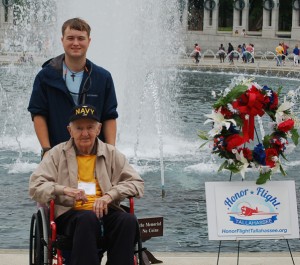Sedona AZ (December 11, 2013) – “I have used a motorized chair. I have used a manual chair. This work I do is important to me because I know how it feels.”
Martin Sheppard served in Operation Desert Storm with the Army’s 8th Infantry Division and later with 10th Mountain Division. He can relate to other Veterans, especially combat Veterans. He suffered an injury during his active duty service that crushed his knee and broke his spine, so Martin knows, intimately, the reality of depending on wheelchairs.
Now he serves as a prosthetics equipment servicer at the Charles George VA Medical Center in Asheville, N.C.
After his accident Sheppard endured nine knee surgeries and one emergency surgery on his spine, after a spinal cord tear and pressure on nerves left him temporarily paralyzed from the waist down. The spinal surgery was successful and, after rehabilitation, he can now walk.
“He has always taken care of me,” said John Rice, a Veteran and beneficiary of Sheppard’s work. “He does all he can to help me.”
Rice is one of the more complex cases for Sheppard because he is a double amputee with a high above-the-knee amputation on one leg and a below-the-knee amputation on the other leg. Rice’s unbalanced body symmetry makes it difficult for him to fit comfortably to his motorized chair. As with all patients, Sheppard spends extra time ensuring Rice has what he needs.
“People like John make you want to come to work,” Sheppard said. “You can see the impact in their lives and that keeps you going.”

On Saturday May 11, 2013 a group of nearly 80 veterans from North Florida and South Georgia took a day trip to Washington D.C. to visit national monuments that have been symbols of a thank you for the sacrifices they have made for their country. Over the years Wheelchair Foundation has donated several hundred wheelchairs to different Honor Flights chapters throughout the US. If you are in need of a wheelchair, visit www.wheelchairfoundation.org. The Wheelchair Foundation, a division of Global Health and Education Foundation,
a 501(c)3 charitable foundation, has a goal to provide a free wheelchair to every child, teen and adult worldwide who needs one but has no means to acquire one.
Sheppard’s work extends far beyond his wheelchair shop on the medical center campus. He makes frequent site visits to vendors who are contracted to work with Veterans in Western North Carolina. Like Sheppard, the vendors help with a range of mobility issues, including manual and power wheelchair repair, vehicle lifts and ramps for patient homes. Sheppard makes sure the vendors deliver the services promised and that they treat his fellow Veterans with respect. Occasionally he’ll visit Veterans’ homes to inspect the vendor work and mediate disputes, but mostly he spends his time working from his shop in Asheville.
Sheppard is also, perhaps, one of the most well-connected employees of the Charles George Medical Center. He serves and has direct contact with about 3,000 patients in Western North Carolina, and his work touches both inpatient and outpatient care. He also works with several other VA departments, such as electrical and welding shops, to build or modify custom devices for his patients.
“It’s a complicated job,” he said, “but the way I feel is that whatever comes in my shop goes out better. Sometimes I repair equipment, sometimes I clean it. Sometimes I just listen to Veterans and have a conversation and help them improve their mood.”
Being a one-man shop also has disadvantages beyond an enormous workload.
“If things screw up – it’s my fault,” Sheppard said. “It also means that after this many years, I’ve figured out how to fix most situations.”
In 10 years of working with thousands of Veterans, Sheppard has seen many changes in his patients’ conditions. Usually the migration goes from good to bad – Veterans lose mobility and need to use motorized chairs. Occasionally he will see patients change from motorized chairs to manual chairs to walking again. When that happens, patients like Sheppard usually keep a chair handy, just in case.
“I keep a manual chair because while I can still walk, I can’t walk too far,” he said. “If I’m going out for a while with my wife and kids I usually take a chair so that I can keep moving.”
And he says it’s all about moving.
“You don’t want to use a power chair if you can help it. You don’t want a scooter either. Once you go power your health could decline. My advice is to stay active as long as you can.”




Semper Fi
Randy,
Thank you Randy for what you do to improve the physical and mental quality of life for our counties wounded warriors.
Only those physically or emotionally wounded in a combat situation will totally appreciate the challenges of our wounded warriors and where their boots have taken them.
I couldn’t let this piece go unnoticed and I hope other wounded warriors and Americans comment on Randy’s work and dedication to serve those that serve our country.
War is something that isn’t easy to talk about, and the price is extremely high for those who return home and are changed forever.
As a country, if we are going to send our men and women to places where they are injured, then we the people (the taxpayer) need to care for them from that point forward – or quit sending them to places we claim make our country and the world a better place to live.
Gary Chamberlain
Cornville AZ
Vietnam Combat Veteran
Don’t miss this!
http://www.godvine.com/Members-of-Our-Military-Surprise-Tourists-With-a-Must-See-Flash-Mob-4357.html